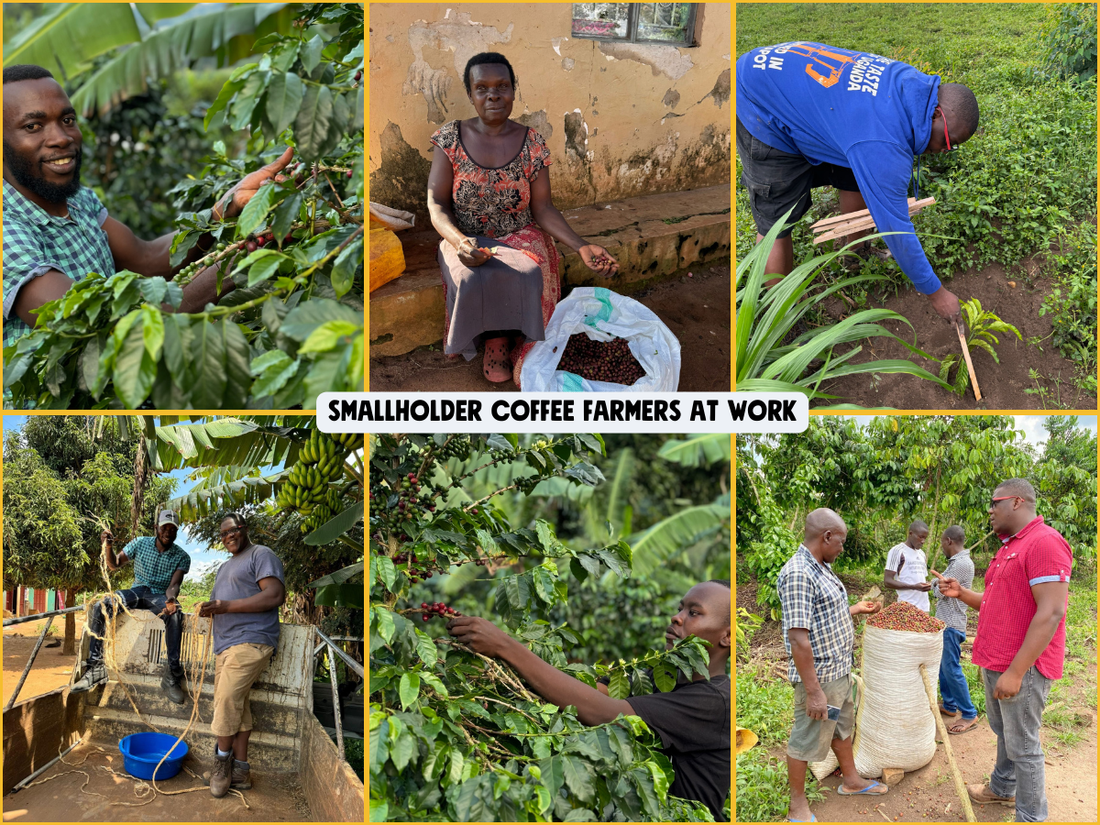THERE IS NO REST FOR THE SMALLHOLDER COFFEE FARMER.
The Robusta coffee harvest in Uganda happens twice a year. The first harvest is between April and June, the second is between October and December.
However, as with all things dictated by nature, there can be some stretching of these periods due to weather, and mostly, rain. In fact, Wycliffe missed Christmas last year (2023) because he was still harvesting through to January. He is still making it up to his wife.
When the harvest is complete, you will see that there is little room for rest... here we take you through the calendar of the smallholder coffee farmer.
Coffee harvest, coffee buffet...
During the coffee harvest, not all coffee cherries will ripen at the same time.
There will be a period, towards the beginning of the coffee harvest, where the bulk of the cherries will be ripe at the same time - that’s when you do the bulk of the picking (some 40% or so). This will be your main helping.
After that, and sometimes, just before the main helping, you go in for a “nibble” - 10% one week, then another 10%… Like the buffet table at a party, you have your main helping, but who doesn’t go back for a nibble?
Coffee knots…
As you get to the end of the coffee harvest, and all of your ripe cherries have been picked, you will already have a good idea of what the next harvest will bring. Why? Because on the coffee trees, you will see some coffee knots; groups of green, baby coffee cherries that will ripen in around 6 months.
Pruning and bending
When the coffee harvest is complete, it is time to prune… and bend.
The coffee trees need to be pruned so the tree’s energy can go into growing its fresh coffee cherries, you don’t want its energy to be wasted travelling down the branches you have just harvested from.
The baby trees need extra care and some guidance; makes sense, they are babies. A coffee farmer will carefully train or “bend” the coffee tree's branches so that they face the direction of the sun. This will create stronger branches for the longterm… Much like people, we grow stronger when we encounter challenges.
After pruning, comes clearing. The grass that has grown around the coffee cherries will be cleared to reveal the soil. If we leave the grass to grow wild, it will compete with the coffee for the soil’s nutrients. So, alas, we say goodbye to the grass. This is also the stage where manure can be added for those using organic fertilisation or where conventional nitrogen-based fertilisers can be added.
THAT'S THE HARVEST DONE...
BUT, nature tells us that when one thing finishes, another begins. Keep reading for what happens next...

Hello, maize!
When one thing finishes, another begins… Just as the coffee harvest is finishing, maize is starting to ripen ready to be harvested. When we said that a smallholder coffee farmer has no time for a break, we really meant it.
Our fellow farmers harvest maize in January. They will keep some to feed their families and what is left can be sold. We buy maize from our neighbouring farmers provide meals for local schools as part of our Schools Feeding Program it’s a virtuous circle.
And that’s why when people says “sustainability”, we think about maize!
Hello, beans!
Now that the ground has been cleared and the soil prepared, it is time to plant beans. We could talk all day about beans alone.
Not only do they provide food for farming families, they provide nitrogen for the soil (good for coffee growing) and because they grow quickly, farmers tend to them often, and while they’re at it, they will give their coffee trees some extra attention too (if you’re in the area, you might as well).
Coffee trees enjoy company and there are a number of crops that you will find growing close to it.
Banana, Passionfruit, Jackfruit, Avocados, Sweet potatoes and Peanuts are on-trend in the northern hemisphere, but you will also find them growing near coffee trees because they provide nutritious food for farming families and important, leafy shade for coffee trees - multi-purpose.
And that, in a nutshell, is the calendar of the coffee farmer. As you can see, it is rather busy. Wycliffe and our team in Uganda also process coffee once it has been harvested. You can follow our work through the year on the Blue Turaco instagram channel.


